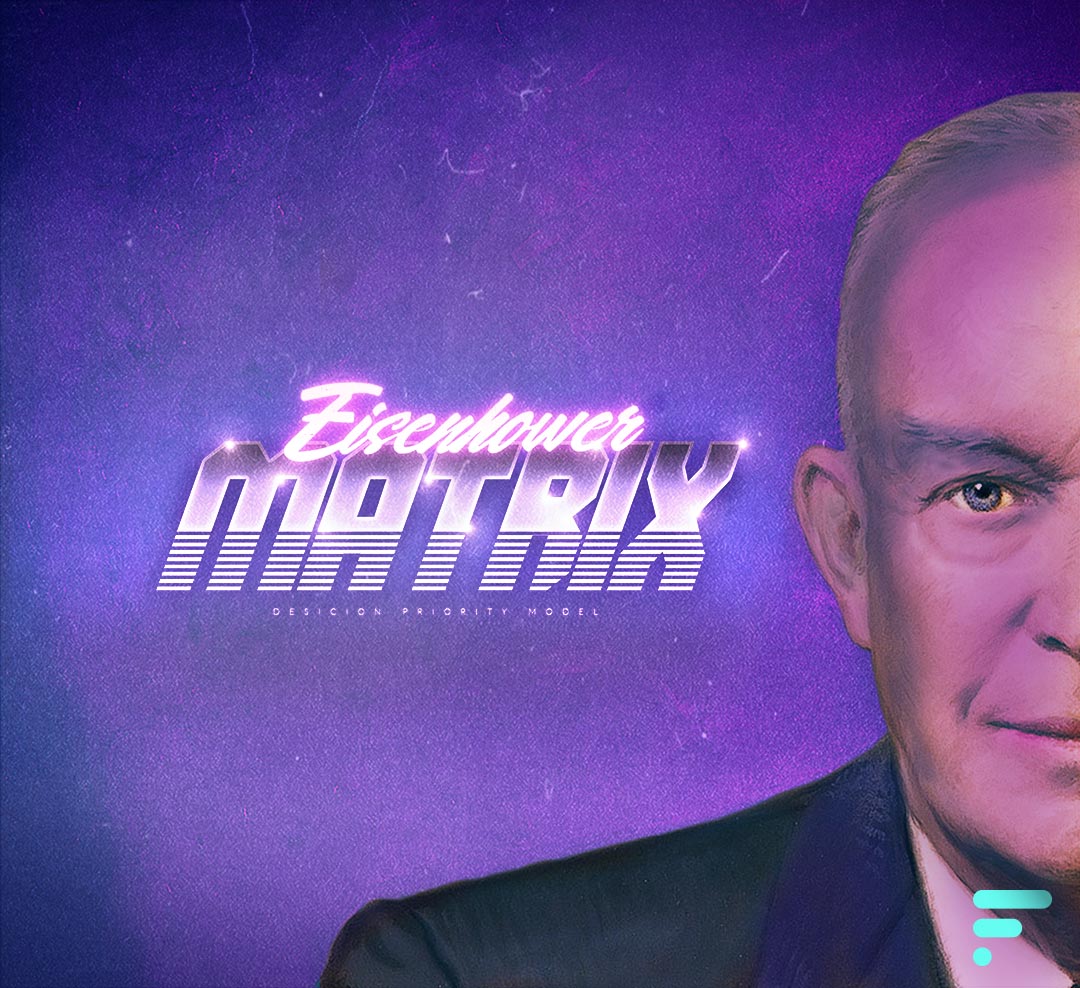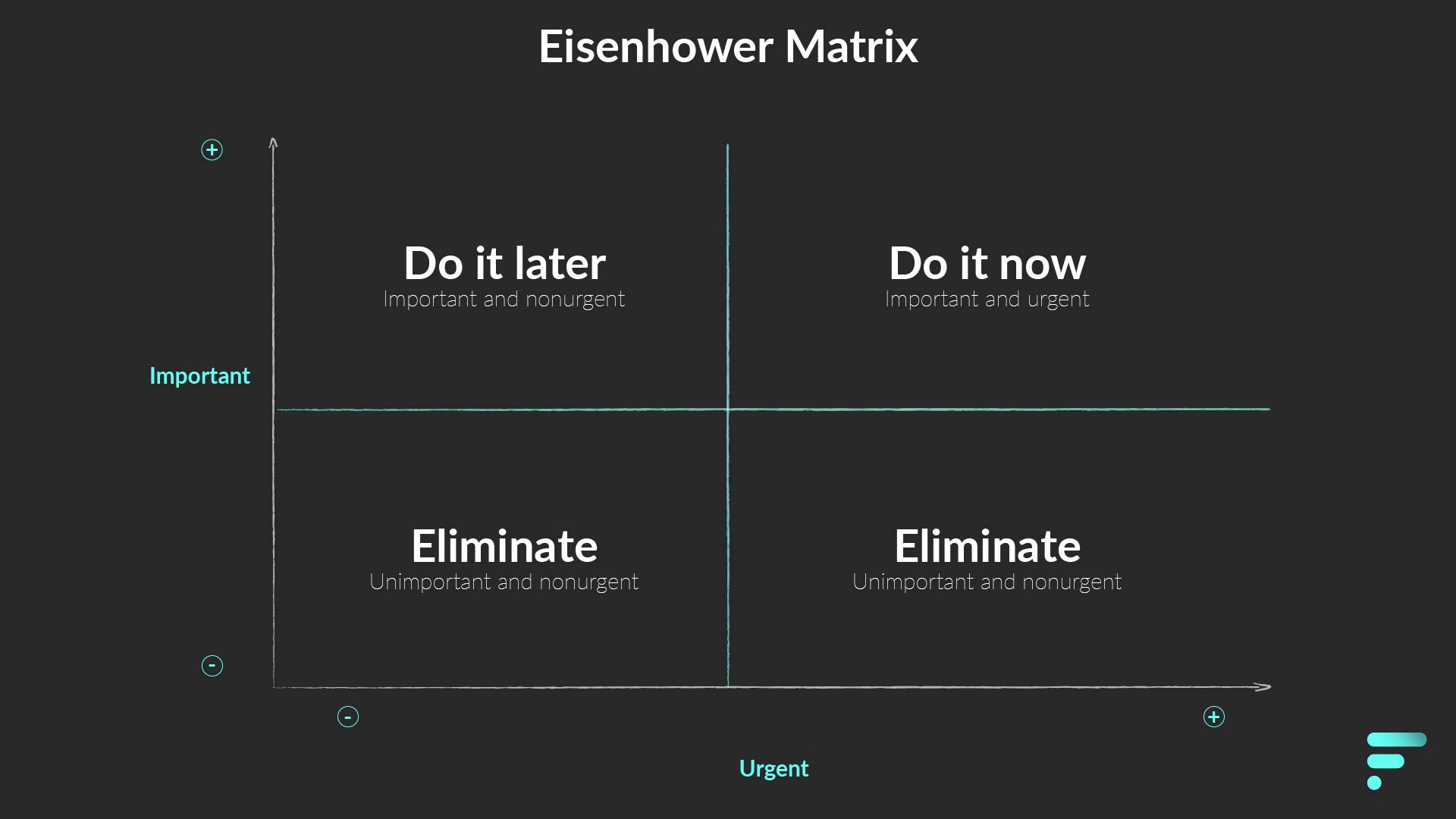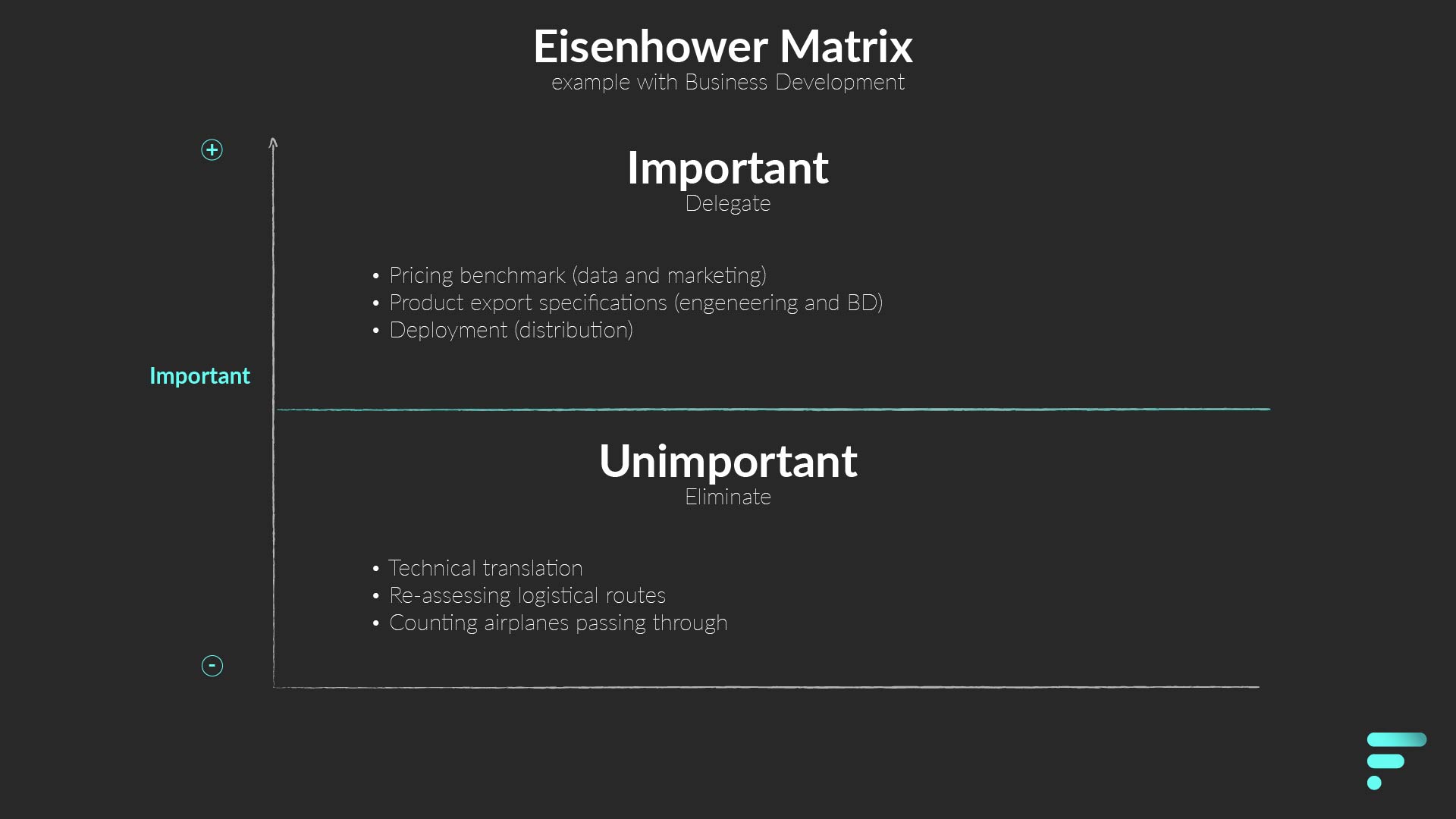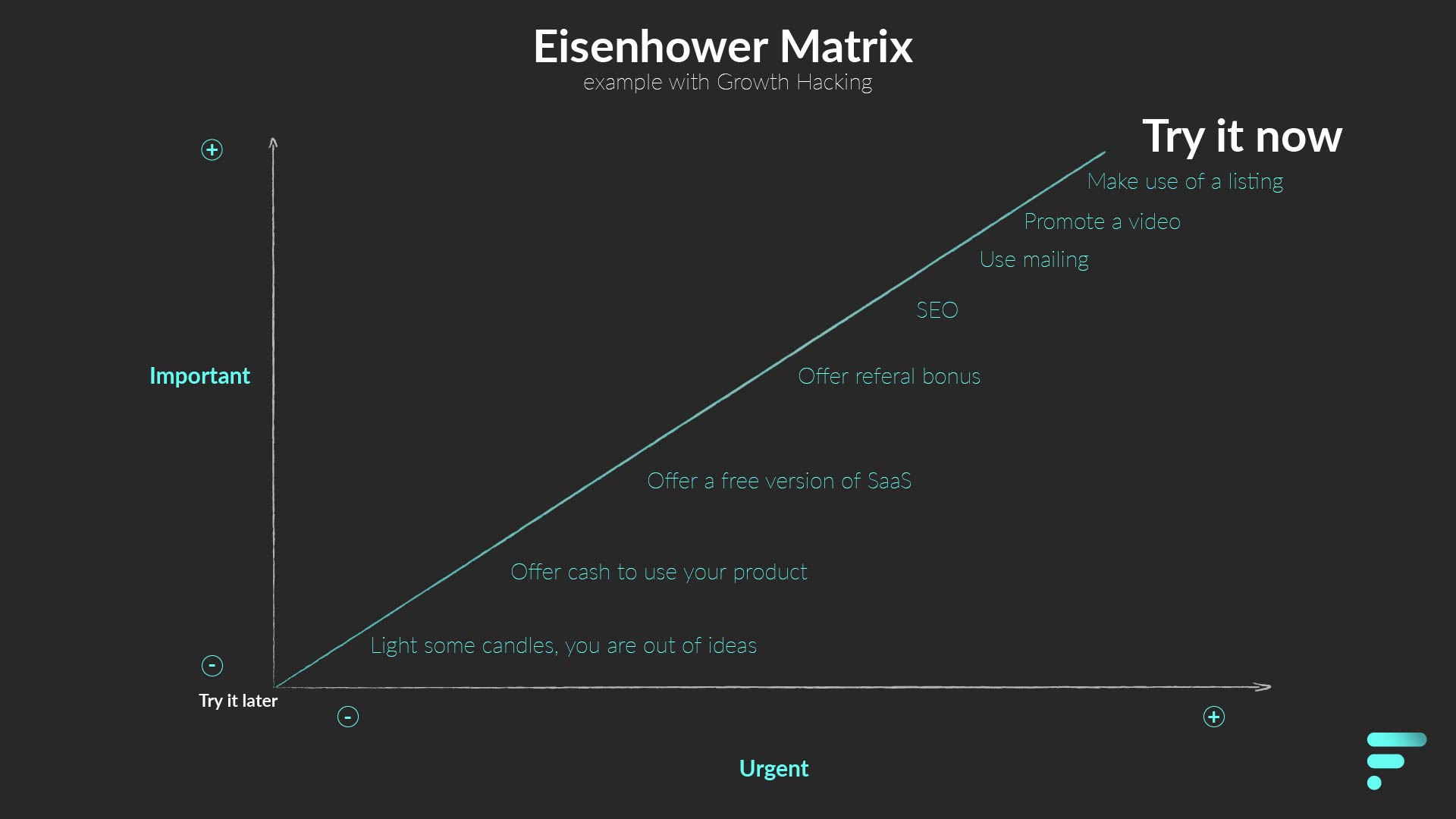Increasing productivity by prioritizing
Productivity Hack with Eisenhower Matrix

Dwight Eisenhower, the 34th President of the United States and mysterious author of the Eisenhower Matrix, has undergone a great image transformation during the passage of time.
Revered before and during his presidency, falling from popularity after his presidency and admired as the decades passed by.
Contemporaries of his generation may have looked at him as someone whom was frequently fishing or golfing. A president that did nothing and left everything to his aides.
Others have looked at him as the person whom got meaningful things done. One who supported the growth of the economy and avoided war when possible.
In the future though, his ability to decide what to do in certain situation is what made him admirable. A president whom did not necessarily receive credits or recognition for the efforts he helped accomplish but got things done. Or equally important, for the things he did not do.
More recently though, Eisenhower has developed an image of a productivity guru and one of his most well-known strategy is called the Eisenhower Matrix (or Eisenhower Box).
Eisenhower Matrix: prioritize your actions
Getting things done does not mean you need to frantically run between errands. Nor does it mean stuffing your to-do lists with incremental tasks to accomplish a feeling of fulfilment.
There is only a finite amount of time during any day and there is only so much you can accomplish during a day. The time in a day is fixed and so are your energy levels (more or less).
When you understand the concept of time and the amount of energy you have to accomplish your tasks, it makes sense to look at it from an urgency and importance perspective.
Eisenhower understood that as no other and the Matrix reflects that. Splitting your tasks into one of the four quadrants, allows you to prioritize the actions or tasks that are the most urgent and important.
There are four possible outcomes by putting the task in the matrix:
- Important and urgent: do it now;
- Important, but not urgent: do it later;
- Urgent, but not important: delegate;
- Neither important nor urgent: delete.

The model is quite versatile as you can quickly pick it up and use it in your day-to-day tasks. You can also use it for larger projects, as it allows you to prioritize what has the most impact (read: Pareto Principle).
More importantly though, it will teach you to delegate or eliminate tasks based on what is important and what is urgent.
Eliminating what is unimportant and nonurgent
Although this model cannot show you what the cost of elimination (or inaction) is, it can help you categorize what is unimportant and nonurgent. This will be a bit tricky at the start, but will have the most impact on whatever you have decided to apply the model on. Have you ever wondered what is the fastest way of getting something done? The answer is not doing the task at all.
Now the cost of elimination may not be visible for you in present. You may fear of it becoming something bad, that it may deter you from eliminating a task and forcing you to place it into a different quadrant. The trick to this though, is to be happy with the consequences by choosing to act or not to.
Consciously making the decision to not act is a decision by itself. Accepting the consequences of it becoming something else, will allow you in the future to place it into another quadrant if needed.
Furthermore, if you do not eliminate tasks but place it in the do it later quadrant where most of these things will belong, it will force you to look at it repeatedly. Which will end-up as an enormous to-do list.
This enormous list is, at least for me, normal. These are tasks you want to observe but not act upon and then as time progresses eliminate it or act on it. They are not unimportant enough to delegate and not urgent enough to completely eliminate. Things that may appear on the to do later quadrant are non-specific things like business opportunities that are opening or keeping an eye out for competitors.
What is important and what is urgent
Urgent tasks are the tasks in which you feel that you need to react to promptly. Something that requires your input now or in the immediate future. It may be a que or beep from your phone or it may be a representative that wants your direct attention. These encounters are on the lower-end of urgency, but it may feel like you need to react to them immediately.
On the higher-end of the urgency spectrum, there can be tasks that need to be done now or in the immediate future, but it does not require you to do it. In other words, it does not require your attention to do the urgent tasks, despite them needing to be done (which is why you delegate these tasks). It can be something like booking a flight to somewhere to getting batteries for your computer mouse.
The difference between high urgency and low urgency is that you can eliminate the tasks that are have lower urgency, like looking at your phone, and not encounter any repercussions.
Important tasks are tasks that help you achieve goals. Things that help further a co-jointed mission or just something that you envision. In other words, things that you need to do in order to achieve your objectives.
Eisenhower Matrix in Business Development or Growth Hacking
The Eisenhower Matrix can be very well used for Business Development or Growth Hacking purposes. For both instances the model can be used as is. However, I do prefer slightly adapting the model to suit better the role and the objectives that come with that role.
As with anything business related you will need to find the goal and cast the approach you need to take. Once you have set the goal it is important to look at the tasks at hand and where to spend most of your energy. Here is the difference.
Eisenhower Matrix in Business Development
With Business Development you will only look at important and unimportant tasks. Urgency is relative and should be taken into consideration when you enter the planning and delegation phase. Not before.
Looking at the important and unimportant tasks is the main task itself, because often you will need to delegate tasks to accomplish an objective. Urgency is secondary because you first need to figure out what you need to do and later decide when to do it (prioritizing).

In this case you will spend most of the time deciding on what is important and what is not. Once you have that figured out you can start eliminating and distributing the tasks. Everything that is unimportant will get eliminated. The rest delegated.
Tasks can and should also be distributed to yourself, but in this role you will more than likely need the help of other people to fulfill an objective.
Prior or during the task distribution you should decide on the urgency of tasks. I prefer to look at what tasks have the most impact or which pieces need to be finished before the rest can proceed. By identifying those two parameters you can have a good idea what is more urgent.
Eisenhower Matrix in Growth Hacking
With Growth Hacking urgency is the leading motivator. Importance takes a secondary role because Growth Hacking is centered into achieving a (growth) objective in a short amount of time.
With Growth Hacking low-cost, rapid testing and swift movement is key into finding the goldmine that grows a business quickly (generally before cash runs out in a business).
The result thereof is that for a Growth Hacker everything can be seen as important. Everything can be the advantage a business is seeking to grow.

This does not mean the Growth Hacker needs to run wildly without any sense of direction (importancy). Though, the Growth Hacker will not know how important something is until they have actually tested it.
So how do you prioritize urgency? You either go with the knowledge you have from previous Growth Hacking sprints, data or you go with your gut. You have to realize that testing and failing can be a quicker learning procedure than the traditional way of conducting sustaining long-term growth.

Share this Page



